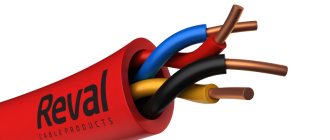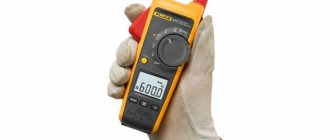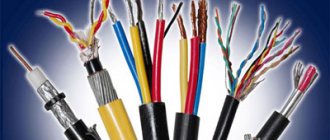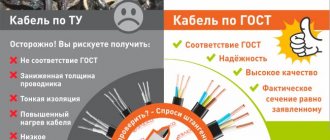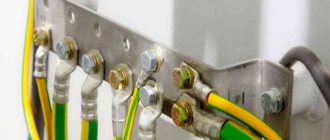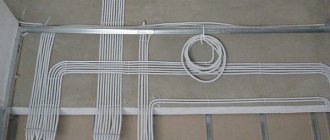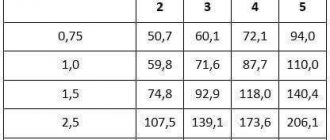Property owners often have difficulty deciding which wiring is better - copper or aluminum. This question faces private developers and owners of city apartments that are planning major renovations. Not only the operational characteristics of the housing, but also the safety of the owners’ residence depends on the correctness of the decision made. In order not to make a mistake in choosing electrical wiring, you need to understand the pros and cons of each material, find out the common points and fundamental differences.
What to look for when choosing wires
Diagram of copper and aluminum wires
When choosing between copper or aluminum for wiring, you need to take into account several criteria on which the efficiency of the electrical system depends.
You need to pay attention to the following nuances:
- Locations of sockets, lighting fixtures, packet and key switches. Based on the diagram, you can calculate the required cable footage.
- The total power of devices that will simultaneously be connected to the network. The result is an indicator of the maximum current load of the wires.
- Socket standard. They are adapted for connecting cores whose diameter does not exceed 2.5 mm. Current load and electrical conductivity of metals are correlated.
- Material cost. This parameter should be the last thing to focus on, since safety comes first.
We should not forget about such criteria as durability. Replacing communications is too expensive and time-consuming to carry out once every few years
Copper wiring
Copper wiring began to appear after the opening of the Iron Curtain, when imported powerful electrical appliances began to arrive in the country.
The aluminum network that had been used for years began to not withstand such a load and they began to replace it with copper. Apparently, this is why the question arose, which wiring is better, copper or aluminum.
At the very beginning of the article it was said that this is not a completely correct question. Under nominal conditions, both copper and aluminum conductors behave the same.
They just have slightly different metrics that need to be taken into account. In what ways is copper considered better than aluminum?
Advantages
There are two main arguments in favor of copper:
- strength;
- conductivity.
Indeed, copper, due to its higher density, can withstand greater mechanical loads than aluminum.
Due to its higher melting point, copper retains its shape better, which is especially important in contacts. The conductivity of copper is 1.7 times better than that of aluminum, which makes it possible to use wires of smaller diameter that can carry the same current
| Permissible current load on wires and cables with copper and aluminum conductors in polyvinyl chloride insulation (type VVG, VVGng, AVVG, etc.) - table GOST 31996-2012. |
| In the air (corrugation, trays, box, etc.) | Section, mm2 | In the ground | ||||||||||
| Copper conductors | Aluminum conductors | Copper conductors | Aluminum conductors | |||||||||
| Current, A | power, kWt | Current, A | power, kWt | Current, A | power, kWt | Current, A | power, kWt | |||||
| 220 V | 380 V | 220 V | 380 V | 220 V | 380 V | 220 V | 380 V | |||||
| 21 | 4,62 | 13,81 | — | — | — | 1,5 | 27 | 5,94 | 17,75 | — | — | — |
| 27 | 5,94 | 17,74 | 21 | 4,62 | 13,81 | 2,5 | 36 | 7,92 | 23,66 | 28 | 6,16 | 18,41 |
| 36 | 7,92 | 23,66 | 29 | 6,38 | 19,06 | 4 | 47 | 10,34 | 30,89 | 37 | 8,14 | 24,32 |
| 46 | 10,12 | 30,24 | 37 | 8,14 | 24,32 | 6 | 59 | 12,98 | 38,78 | 44 | 9,68 | 28,92 |
| 63 | 13,86 | 41,42 | 50 | 11 | 32,87 | 10 | 79 | 17,38 | 51,93 | 59 | 12,98 | 38,78 |
| 84 | 18,48 | 55,22 | 67 | 14,74 | 44,04 | 16 | 102 | 22,44 | 67,05 | 77 | 16,94 | 50,62 |
| 112 | 24,64 | 73,62 | 87 | 19,14 | 57,19 | 25 | 133 | 29,26 | 87,43 | 102 | 22,44 | 67,05 |
| 137 | 30,14 | 90,06 | 106 | 23,32 | 69,68 | 35 | 158 | 34,76 | 103,87 | 123 | 27,06 | 80,86 |
| 167 | 36,74 | 109,78 | 126 | 27,72 | 82,83 | 50 | 187 | 41,14 | 122,93 | 143 | 31,46 | 94,00 |
| 211 | 46,42 | 138,71 | 161 | 35,42 | 105,84 | 70 | 231 | 50,82 | 151,86 | 178 | 39,16 | 117,01 |
| 261 | 57,42 | 171,58 | 197 | 43,34 | 129,51 | 95 | 279 | 61,38 | 183,41 | 214 | 47,08 | 140,68 |
| 302 | 66,44 | 198,53 | 229 | 50,38 | 150,54 | 120 | 317 | 69,74 | 208,4 | 244 | 53,68 | 160,41 |
| 346 | 76,12 | 227,46 | 261 | 57,42 | 171,58 | 150 | 358 | 78,76 | 235,35 | 274 | 60,28 | 180,12 |
| 397 | 87,34 | 260,98 | 302 | 66,44 | 198,53 | 185 | 405 | 89,1 | 266,25 | 312 | 68,64 | 205,11 |
Flaws
What is a plus for aluminum is a minus for copper:
- price;
- weight.
Copper itself is about 4 times more expensive than aluminum, so to make repairs less expensive, it makes more sense to use aluminum. Secondly, it's weight. With the same cross-section, an aluminum wire will be much lighter than copper.
Properties of aluminum
Aluminum wiring bends easily, but breaks quickly.
Aluminum belongs to the category of light, chemically and biologically inert metals with a specific gravity of 2700 kg/m³. The material is safe for humans and the environment.
Advantages of aluminum:
- Affordable price. The price is determined by the lower melting point and lower production costs than other metals.
- Plastic. The wire bends well, maintaining its shape. The cores are given any configuration required for the job.
- Formation of a protective layer. After stripping, the metal surface is covered with a thin layer, which prevents its oxidation throughout its entire volume.
However, aluminum has the following disadvantages:
- High degree of resistance to electron flow. This causes the lines to heat up, which can cause the finishing materials to catch fire.
- High level of thermal expansion. Because of this, weakening of contact connections occurs. When lines with a high load are frequently switched on and off, the circuit becomes disconnected.
- Oxidation upon contact with air. The resulting film has poor conductivity, which causes the contacts to overheat and melt the insulation, and the ground line simply ceases to perform its function.
- Short service life. It does not exceed 30 years under average load.
Today, in accordance with GOST requirements, the use of aluminum is prohibited in the construction of residential buildings and engineering structures.
Properties of copper
. Copper is a heavy metal with a specific gravity of 8700 kg/m³. This indicator should be taken into account only when laying power lines with a limited safety margin of the supports. In everyday life it can be neglected. The material actively interacts with oxygen, forming an oxide - a patina, which can be seen on statues, fences and souvenirs.
The advantages of copper are as follows:
- Durability. If the line does not run outdoors, it can last 30-50 years depending on the humidity of the room.
- Strength. Copper is resistant to twisting and bending. A high-quality cable can be deformed up to 100 times without losing its performance characteristics.
- High conductivity. The metal allows electrons to pass through easily without being subject to heating or thermal expansion.
- Flexibility. The wiring easily takes the desired position, straightening after the load is removed. It is convenient to work with cables during the installation process.
The material also has disadvantages:
- High price. This is explained by the difficulties of ore mining and the costs of processing it. Melting the concentrate requires a large amount of energy, plus transportation costs.
- Oxidation when interacting with water and air. The resulting film impairs the conductivity of the contacts and contributes to their heating.
When choosing between aluminum or copper wiring, it is advisable to choose the second option, since it has more advantages than disadvantages.
Which conducts current better?
This indicator determines such properties of the wiring as its maximum power, durability and fire safety.
The following operational characteristics of the laid line depend on conductivity:
- heating losses from electron flow;
- preservation of current parameters, which is important for sensitive devices;
- the degree of increase in cable temperature during operation of powerful consumers;
- the presence or absence of a smell from melting and burning wiring in the room.
To understand which conducts current better - copper or aluminum, you can compare the degree of their resistance. The lower this indicator, the lower the likelihood of adverse events occurring.
This indicator is:
- copper - 0.018 Ohm×mm²/m;
- aluminum - 0.028 Ohm×mm²/m.
Copper conducts current more than 1.5 times better. Resistance compensation is achieved by increasing the cross-section of the cable cores.
Alloy characteristics
The electrical conductivity of metals can depend not only on the amount of impurities present in them, but also on other indicators. For example, as the heating temperature increases, the ability of copper to pass current through itself decreases. Even the method of its manufacture affects the electrical conductivity of such wire. In everyday life and in production, both soft annealed copper conductors and hard-drawn ones can be used. The first variety has a higher ability to pass current through itself.
However, the additives used and their quantity have the greatest influence on the electrical conductivity of copper.
The table below provides the reader with comprehensive information regarding the current carrying capacity of the most common alloys of this metal. Electrical conductivity of copper alloys
| Alloy | Condition (O - annealed, T - hard-drawn) | Electrical conductivity (%) |
| Pure copper | ABOUT | 101 |
| T | 98 | |
| Tin bronze (0.75%) | ABOUT | 55-60 |
| T | 50-55 | |
| Cadmium bronze (0.9%) | ABOUT | 95 |
| T | 83-90 | |
| Aluminum bronze (2.5% A1, 2% Sn) | ABOUT | 15-18 |
| T | 15-18 | |
| Phosphor bronze (7% Sn, 0.1% P) | ABOUT | 10-15 |
| T | 10-15 |
The electrical conductivity of brass and copper is comparable. However, for the first metal this figure is, of course, slightly lower. But at the same time it is higher than that of bronzes. Brass is used quite widely as a conductor. It passes current worse than copper, but at the same time it costs less. Most often, contacts, clamps and various parts for radio equipment are made from brass.
Which wiring material is better?
With all the advantages of aluminum, one should not forget about its disadvantages. The main one, apart from mechanical characteristics, is low conductivity. It is impossible to endlessly increase the diameter of the cable, since household appliances and channels laid in the walls are not designed for this. We should not forget about such a factor as the fragility of the metal. After several years of use, it may burst when replacing an outlet or meter. It is not advisable to twist it in the socket box, as it will not last long. Choosing aluminum will provide good savings on the purchase of materials, but subsequent repair costs may negate this.
Copper also has its disadvantages, but they are offset by a large number of advantages. Even the process of pulling the cable through the channel is easier, since it bends well without any tendency to break or break. It is worth remembering about low resistance. By installing a line with 2.5 mm² conductors, you can use as powerful consumers in your home as the common house line allows.
To summarize, we can recommend that craftsmen make their choice in favor of copper products. If the budget is limited, you can combine materials using modern switching means.
Why can't you twist aluminum and copper cables?
Of course, if you are planning to rewire your home and are unable to install all the electrical wires made of copper, you can combine these two types of wiring. In other words, you can use aluminum cables to supply current to lighting fixtures and copper wires to supply current to outlets or powerful electrical appliances. At the same time, in some places it will be necessary to connect copper and aluminum wiring.
It should be noted from the outset that direct contact between copper and aluminum is, at a minimum, not recommended. This means that it is impossible to twist electrical wires made of two metals. Why? The reason lies in their physical properties. These two metals have different conductivities and, as a result, the junctions between them will heat up. This is also facilitated by the presence of oxidizing films.
If we talk about the oxidation film on copper wiring, then it can conduct current and therefore does not greatly affect heating. But the same film on an aluminum electrical wire has a strong resistance and, accordingly, passes less current. This fact increases the heating. As the cables heat up, they expand. Since copper is a harder metal than aluminum, copper electrical wire leads to some deformation of the aluminum wire. As a result, when cooling occurs, the connection itself looks slightly different.
After heating and cooling several times, the connection becomes loose, leading to problems such as overheating, sparking, and burning. The appearance of a galvanic couple also occurs. However, it only appears when moisture gets into the connection. Otherwise, this pair will not form. A galvanic couple appears because at the junction of such wires, which we call copper and aluminum, dissociation of the oxides of the electrical wires begins. This process involves the breakdown of the oxide into charged ions.
After this, charged ions of copper and aluminum oxides become direct participants in the process of current movement. As a result, they transfer charge and also move. This feature leads to the destruction of the metal. Ultimately, voids and cavities form in the wiring. They in turn reduce the cross-section and ability of the wiring to pass current.
The end result is overheating of the joints. As we have already noted, this process occurs only in the presence of moisture. And the more moisture there is at the twisting site, the faster the dissociation becomes. I think you have already understood that it is impossible to allow moisture to get into the connection, and also to allow direct contact between copper and aluminum wires.
Useful tips
The cable layout in the apartment consists of an upper and lower level. The lower one has sockets designed to power consumers, the power of which can reach 2 kW: washing machines, boilers, microwave ovens. In order not to expose the lines to the risk of overheating and burning, it is advisable to install a copper cable with the maximum cross-section of conductors allowed for household outlets.
The upper level is used to power doorbells, ceiling and wall lamps. These products consume a minimal amount of electricity, especially if they are equipped with modern LED lamps. You can run a thin and inexpensive aluminum cable on top, the power reserve of which is sufficient with a large reserve. With this solution, a separate issue arises of a safe way to join two incompatible metals.
Conductive paste
To avoid problems with contacts after installation, you can use one of the following devices:
- Clamp. The product consists of 3 steel plates. The cores are inserted between them, after which the plates are tightened with bolts.
- Bolt with 2 iron washers. The ends of the cores are twisted into rings and placed on the axle, and washers are installed between different materials. Tightening the nut ensures reliable contact.
- Spring switch. Its terminals are treated with a special anti-corrosion lubricant. The cores are inserted into the grooves and secured with spring levers.
- Pads. They are a steel strip with contacts pressed into a plastic case. The ends of the cable are inserted into the holes where they are tightened with bolts. The products can be used to connect 2-10 pairs of wires.
To avoid oxidation of wires, copper should be soldered, and aluminum should be coated with a special conductive paste.
Connectors for wires and cables
Connectors are special devices that facilitate the connection of two or more conductors. There are screw and clamping mechanisms.
Screw terminals
Used to connect wires of different materials and different diameters. An exception is multi-core electrical wires, which are crimped with special lugs. Also, screw clamps can damage aluminum wires, so it is better not to use them for such material.
Power clamp
In such clamps, the stripped conductor is placed in the hole to the end. There it is automatically fixed by a pressure plate. Clamps can be used to secure copper and aluminum wires.
Clips
To install the wire, the clip clamp is placed in a vertical position, the wires are inserted inside, and then the clamp must be moved to a horizontal position. Plus, you can make adjustments.
Spring clamps
PPE caps are used as spring clips. Thanks to them, you can quickly make contact between two wires of similar diameters
It is important to choose the correct clamp, otherwise the contact will be unreliable
Spring terminals
Wago spring terminals ensure reliable contact quickly and efficiently. However, over time, the spring may weaken or overheat.
Connection clamps
There are two types - electrical and electrical. The only difference is the current load. The connection takes place inside the device.
